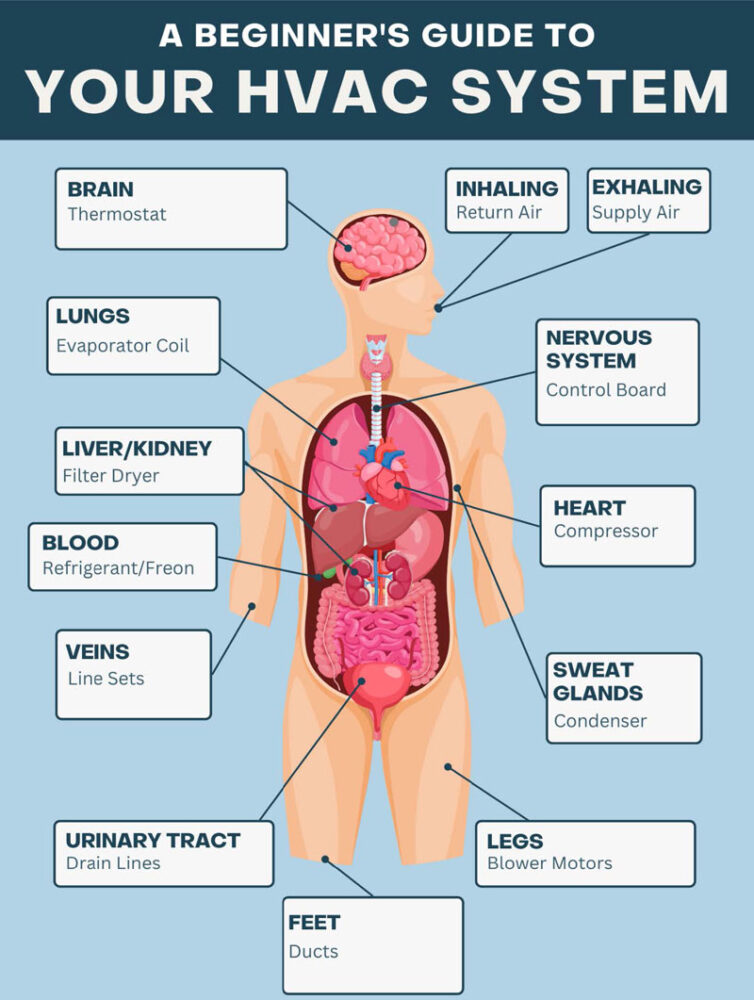How Does Your Home’s HVAC System Actually Work?
When an air conditioning technician visits your home, odds are their explanation of what’s going on with your system will go over your head. The technical terminology in the HVAC industry can be extensive and confusing. Through the simplified information provided below, the equipment in your home and its functionality should make more sense to the average homeowner.

General Function of Your HVAC System:
Compressor: A pump that relocates refrigerant/freon throughout the entire system. The compressor is considered the “heart” of the system, as it circulates the freon.
Refrigerant/Freon: Changes state as it travels throughout your system to effectively cool or heat your home. Freon could be compared to blood as it pumps through your system and keeps you running.
Line Sets: Coming from the compressor are copper lines that feed freon into and back out of the home. When the freon returns, it is in a different state and is ready to be pumped back through the home to effectively heat/cool. Line sets are like veins as they transport the freon (blood) throughout the system.
Filter Dryer: Eliminates any unnecessary or harmful particles from being distributed throughout the home, similar to the body’s liver/kidney filtering out harmful waste.
Condenser: The piece of HVAC equipment that is located outside of the home. This is a heat transfer point for the system, either collecting heat or dismissing heat to the outdoors. The condenser cools down refrigerant just as sweat glands cool our bodies.
Thermostat: The thermostat is the brain of the system. It communicates and controls the temperature changes in the home to maintain desired comfort.
Control Board: Ensures that the entire HVAC system works in unison by allowing all parts and pieces of equipment to communicate with one another and properly cool or heat your home. This aspect could be compared to the body’s central nervous system because of its overall communication to guarantee proper function.
Blower Motor: The blower motor is located in your furnace/air handler and moves air throughout the home, similar to how our legs allow us to move around.
Ducts: Metal tubes that distribute air throughout an indoor space to provide comfort in every area of the building. Ductwork could be compared to feet as it is essentially where movement occurs, similar to walking and running.
Drain Lines: Condensation is naturally produced from your HVAC system. Drain lines work to move any excess moisture away from the unit, like the urinary tract does for the human body.
Evaporator Coil: When the blower motor is operating, air is sent across the evaporator coil. The coil absorbs heat and moisture from the home allowing the air to be cooled and distributed throughout the home via ducts. The evaporator coil could be compared to lungs, as they absorb oxygen and change its state.
Return Air: Can be looked at as inhaling as it is air being taken into the HVAC system.
Supply Air: Can be looked at as exhaling as it is air being blown back out into the home through ducts.
Additional General HVAC Terminology:
HVAC: This abbreviation stands for heating, ventilation, and air conditioning. HVAC systems help homes stay comfortable year round despite scorching summer heat and bone chilling winters. Hvac systems also ensure your family’s health by filtering, cleaning, and circulating air throughout your home to improve indoor air quality.
Air Handler: This is responsible for controlling how the air circulates throughout an indoor space.
Heat Pump: Cools and heats an indoor space strictly by using electricity. Similar to an air conditioner, heat pumps remove unwanted humidity and heat in your home and replace it with cool air. Only heat pumps can also deliver heat during colder months as they have the ability to operate in reverse, drawing heat from outside and bringing it inside, even if it is cold outside. Heat pumps are slowly becoming more popular as modern homes are mostly electric.
Single Package Unit: A heating and air conditioning system that has all components located in one unit outside of the home. Mainly located in commercial settings.
Split System Unit: A heat pump or central air conditioning system that has components located both inside and outside of the home. This is the most common design.
Condenser Coil: An arrangement of tubes filled with refrigerant where heat leaves vapor from hot refrigerant. This vapor condenses into a liquid capable of absorbing more heat.
Amp Draw: Amp draw refers to the amount of electrical current that an electrical component, such as a motor or compressor, draws during operation.
Static Pressure: The resistance to airflow in ductwork or other components.
Hard Start Kit: Used to help ease the start-up process for air conditioners and heat pumps that may be struggling.
Indoor Air Quality (IAQ): Refers to the air quality within buildings, especially as it relates to the health and comfort of building occupants. According to OSHA, it includes factors such as temperature, humidity, and ventilation.
Ton: A ton measures the cooling capacity of an air conditioning system. Generally, one ton can typically heat/cool a 500-700 square feet space.
Variable Speed: This refers to a motor that operates at various speeds to control the flow of hot or cold air amongst the home more accurately.
Heat Specific Terminology:
Furnace: Raises the temperature of an indoor space by using natural gas, oil, or electricity. The heated air is then circulated throughout the space.
BTU: This abbreviation stands for British Thermal Unit and measures the amount of heat required to raise the temperature of one pound of water by one degree Fahrenheit.
Superheat: Calculated as the difference between the saturation temperature of a substance and the actual temperature of the gas.
Cool Specific Terminology:
Air Conditioner: Reduces the temperature of an indoor space by eliminating heat and moisture in the air. This is done by transferring unwanted heat and humidity outside and returning the cooled air inside.
SEER2: This abbreviation stands for Seasonal Energy Efficiency Ratio and measures an air conditioner’s cooling efficiency. SEER2 ratings range from 13-21+, with the highest being the most efficient.
Subcooling: When the liquid refrigerant in your HVAC system is cooler than the minimum temperature required to keep it from boiling.







